
|   |

|   |
|
ANITA SAYS..... The old healer to the soul It's not your back that hurts, but the burden It's not your eyes that hurt, but injustice It's not your head that hurts, it's your thoughts It's not the throat, but what you don't express or say with anger Not the stomach hurts, but what the soul does not digest It's not the liver that hurts, it's the anger It's not your heart that hurts, but love And it is love itself that contains the most powerful medicine - Ada Luz Marquez, Spanish author 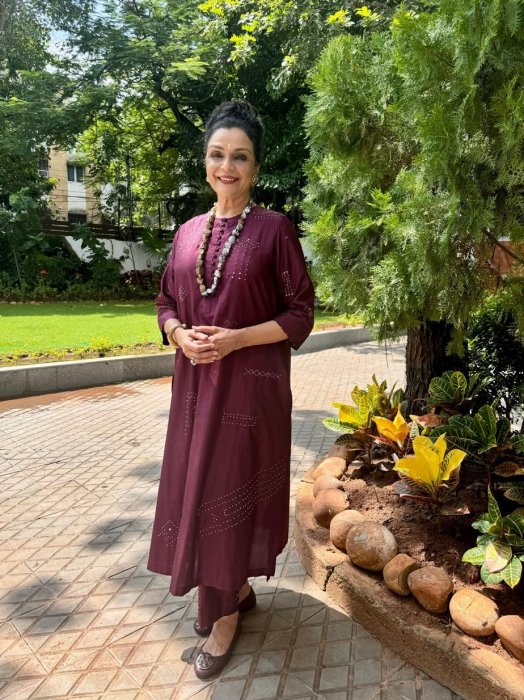
Hello, everyone! I know that wherever you are, the holiday spirit has seized you. New clothes, parties, celebrations for Diwali - the air is sparkling with joy and hope and optimism. And food! And I hope you are all doing what makes you feel fulfilled and grateful.  India's biggest festival of lights is celebrated globally by the diaspora and several years ago the US Postal Department issued a stamp in honour of Diwali. Recently, the state of Pennsylvania in the US has signed into law an official holiday for Diwali. Australia has recently declared October as Hindu Heritage Month. We in the South of India call this popular festival DEEPAVALI - but it's the same meaning. A festival of lights, bursting crackers and new clothes, meeting friends and family, gifting and feasting. A day when the smile muscle is overworked and our faces ache at the end of the celebrations. While I was unable to be physically present due to a family commitment, here are the many reports from friends and dance colleagues that I received about the largest Indian dance gathering of this century. THE LARGEST INDIAN DANCE EVENT OF THE CENTURY 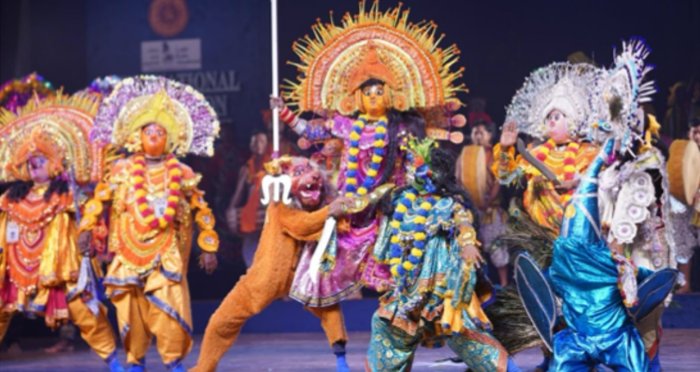 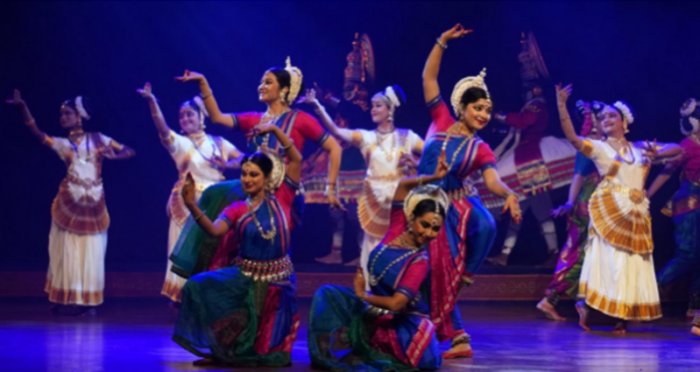 (Photos courtesy: SNA) The International Festival of Indian Dance (IFID) was held over 6 long days in New Delhi. Helmed and managed beautifully by Dr.Sandhya Purecha, Chairperson of the Sangeet Natak Akademi, (India's apex body for the performing arts), IFID was a landmark event for all creators, teachers, students, performers and anyone and everyone involved in the world of dance. Over 6 long days with an average attendance of 700 daily, several aspects of dance were discussed. A fantastic variety of forms were showcased - traditional and indigenous (the suggested new nomenclatures to substitute the terms CLASSICAL and FOLK) reflecting the unique diversity and mind-boggling range of genres from India. From 10am to 10pm every day, discussions, presentations and evening performances covered a dizzying range of topics - financial grants, national statistics in urban and rural areas, policy issues, arts education, copyright challenges, traditions in flux, changing equations in the classroom, arts education for youth, fundraising, professional development, touring grants, design education, identity and gender issues - the list was exhausting but a much needed event to gather experts, practitioners and scholars into one geographical venue across generations to meet, greet, listen and participate. 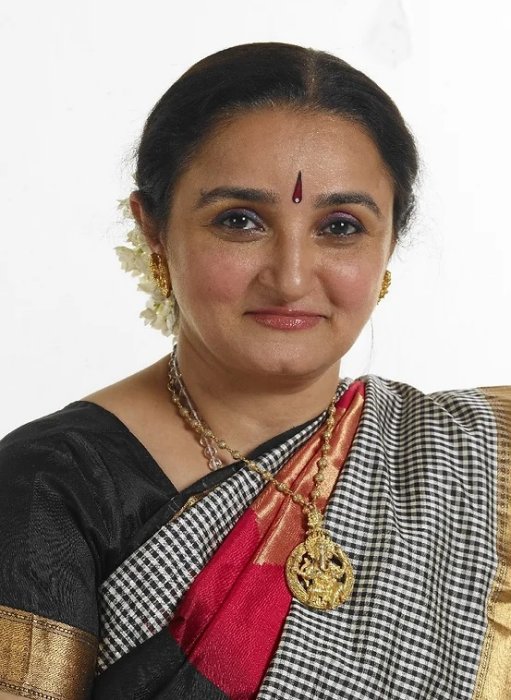 Dr. Sandhya Purecha From the opening keynote and a special message from India's Prime Minister, read by Ananda Shankar Jayant, the impressive event attracted students, dancers and observers from across India - West Bengal and Tamilnadu dominating with its numbers. For many in the Chennai contingent, it was a golden opportunity to be in the nation's capital and listen to so many voices and opinions. Social media handles of many dancers were filled with glowing reports and endless photos of smiling Chennai faces mingling with dancers and elders from across India. The unanimous feeling was that the capital city had so much to offer for creative people with emotional stamina and curiosity. In the unstoppable wave of high spirits that ran through the conference, there were some areas that could have been represented better. The inclusions of the OG DIASPORA pioneers - Hema Rajagopalan/Rathna Kumar/Viji Prakash (USA), Lata Pada (Canada), Anandavalli and Tara Rajkumar (Australia) would have been most welcome. These women have played a crucial role in furthering the presence and popularity of India's dance traditions in their cities and countries. Raghunath Manet (France) and Uttara Coorlawala (USA) represented that generation. Although they are no longer with us, artistes like Ritha Devi, Menaka Thakkar, Indrani Rehman, Bhaskar Roy Choudhary, Ram Gopal, Nala Najan and Matteo are just some of the names that need recalling and acknowledging for their stellar contributions. Ramli Ibrahim, who is today's poster man for diaspora dance, was present along with his SUTRA dancers. WHAT ABOUT CONTEMPORARY DANCE AND BEYOND? A whole new conference is needed to harness and map the bristling energy of contemporary dance in India. The scene has matured greatly since SNA's National Festival of Contemporary Dance decades ago. The rising role of social media influencers and digital dancers, event/cultural managers and donors beyond government and state corporations needs a closer look. Dance and movement therapy for healing is another fast-growing sector that needs attention. While the overall trend of the IFID presentations (5 minutes each!) leaned more towards the past and the historicity of dance, the presence of important cultural bureaucrats was a breakthrough. Having these important individuals face to face with those who are working in the field every single day was a coup that Sandhya Purecha accomplished. In a detailed chart presentation on how resources were allocated, there was an audible gasp in the audience at how much support Odissi/Odisha and the North Eastern states were receiving in comparison to the other parts of the country. 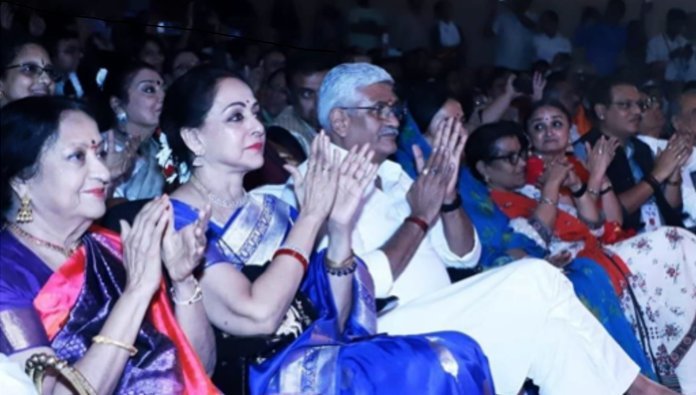 Padma Subrahmanyam, Hema Malini (Photo courtesy: SNA) Film star Hema Malini, a special guest on the final day, bowed to touch the feet of Padma Subrahmanyam and, in her speech detailing her dance journey, acknowledged how crucial Paddu Akka's father, director K Subrahmanyam, was in spotting her talent. It was a touching moment. 1000 attendees hosted, accommodated and fed daily for 6 days. National and international dance artistes from traditional and indigenous streams together - shoulder to shoulder - what an incredible feat accomplished with aplomb by Sandhya Purecha and her able team at SNA. Kudos all around! An important area of focus for the dance world in India today should be about harnessing the growing corporate and technology sector to support the performing arts. Employing dancers on company payrolls like sportspeople was one valuable suggestion mooted at the IFID conference. DANCE IN A MARKET ECONOMY While on the subject of money, it needs to be acknowledged that in a market economy, the modern investor or venture capitalist who is always looking for the hot new idea is NOT looking at dance as a viable property. The return on investment cannot be measured against the expected 200% returns. And yet, there are so many dance organisations and individuals who are able to create careers through a structured system of sustained support. The best examples of public-private cooperation can be seen in countries referred to as FIVE EYES - USA, UK, Canada, Australia and New Zealand. In Europe, the Netherlands has a robust system of steady support for the arts. It is possible to study how every dance organisation, government arts councils and theatres create multiple verticals like teaching, performance, touring, outreach, guest appearances, new commissions, collaborations, audience development and fundraising. Some countries like Australia have a strong policy for indigenous artistes in their budgets. Looking at these at a macro and micro level can perhaps help create a road map that can be adapted to the Indian context. SNA is best suited with the resources and personnel to strengthen the Indian dance eco system. INVESTING IN DANCE DANCE MEDIA CORPORATION in the USA is inviting investors to look at the dance sector as an exciting new business opportunity. This company owns 6 of the most popular dance publications and digital properties - Dance Magazine, Dance Spirit, Dance Teacher, Dance Edit, Dance Business Weekly and Pointe. The company has been created by media entrepreneurs who founded and sold the popular SYFY channel and have now turned their attention to Dance. They have merged with hollywood.com and feel strongly that the entertainment twinning will benefit the dance world enormously. I watched their online pitch delivered with all the professional business markers of investment and returns. The founders, Mitch Rubinstein and Laurie Silvers, feel that by harnessing cutting edge technology and making dancers and dance makers stakeholders in the template, the intersection of dance and entertainment will do wonders for the entire dance industry. VAGUE ANXIETY AND STRESS Are you a professional Indian dancer between age 40 and 50? Then you could be experiencing feelings of isolation and worry. In my meetings and conversations with many artistes in this demographic, I recognise the following common issues. These are serious dancers, professional, talented, capable and committed. The years 40 to 50 are the prime decade for Indian dancers. They have spent more than 20 years honing their craft. However, they find themselves STILL waiting in the wings for the elders to graciously cede space to them. It is not happening. These dance artistes have already been featured on the main stages and important festivals but they have not broken through to star status. Meanwhile, their younger students who are tech savvy are stealing the thunder from under their hard-working noses. These 'social media newbies' are touring, teaching, performing and enjoying the financial success purely from the numbers on their handles. And so this group, who are neither young nor middle aged, find themselves squeezed between these brash newcomers 21to 35 years and the 55 to 70 age seniors who are still occupying centerstage. Can they hold on and hold out without losing steam? Can they find ways to reinvent themselves for changing audience tastes? Will artistic directors and curators focus on this generation who are ready to inherit the mantle? HEALTH CONCERNS - PHYSICAL, EMOTIONAL AND BEYOND Many dancers are neglecting their health. While dancers are looked upon as the epitome of fitness and optimum health, nagging illnesses creep up and explode suddenly. Regular checkups are often pushed aside or postponed (I am guilty of this). We always find excuses and other deadlines to neglect our physical, emotional and spiritual wellbeing. And then it becomes too late. As I write this, some of our colleagues are fighting life battles with the dreaded C. To the world, dancers are not supposed to feel fatigue, despair, distress, mood disorders. Through childbirth, menopause and so much more, dancers wear a smile on stage despite whatever is happening in their lives. So much can be lurking behind that sunny exterior. Mental health issues are a growing concern. Cancer and dementia attack like a silent killer. You can see and feel broken limbs or scars from surgeries. But not what is eating your body and mind from the inside. So please make yourself and your wellbeing as a top priority. INDIA'S CULTURAL SPACES I was seated in the beautiful Kamani auditorium in New Delhi for a landmark event of a friend and dance colleague, Geeta Chandran. It got me thinking of how this iconic theatre was the brainchild of Mrs Sumitra Charatram, arts patron and the matriarch of the Shriram Business Group. Individual and private initiative from corporate India has given us some of the best cultural spaces. The NCPA complex in Mumbai is thanks to the TATA group and the new sensation in Mumbai is the AMBANI funded Neeta Mukesh Ambani Cultural Centre NMACC. Kolkata's Birla Sabhagar and Chennai's Music Academy are just some of the other examples of private money channelled into arts infrastructure. G5A in Mumbai is the result of former textile mill owners. Chennai's exorbitantly expensive Sir Mutha Venkatasubba Rao Concert Hall is the generosity of another business family. Coming up in New Delhi in 2027 is the world class contemporary museum and arts centre created by Kiran Nadar, one of the most prolific art collectors in the world. Together with her husband Shiv Nadar of HCL Technologies, the interdisciplinary museum centre's focus is global excellence through arts and education. Corporate India is still reluctant to donate their CSR money to Dance. Anand Mahindra of the Mahindra Group has put some of his profits into theatre and music festivals. Dance is not on their mind screen. Hero Honda's Munjal family has gifted India with the splendid SERENDIPITY festival in Goa. However, most CSR donations require the dance or arts organisations in India to give the donor visibility, booths, distribute printed handouts, logos at the venue and perhaps more. No longer can dancers expect the one-sided largesse of patrons who write checks with no expectations! WHERE THE SERIOUS MONEY IS Bhu-Viplava Education is a sector that is flush with resources and school/college annual days are always planned with great care with no expense spared. I recently worked with the Omega International School in Chennai for their special event called KALANJALI. Creating a script on the environment written and researched by the students, selecting groups to chant Sanskrit slokas and sing popular environment pop anthems, working with the teachers and board of directors was hard work but rewarding. Budgets were generous and it was possible to integrate 30 professional artistes with 30 students in a multi-layered presentation called BHU-VIPLAVA (the restless earth) Lighting design, original music, costumes, rehearsal space - were all made available. However, these students do not translate into future audiences for dance or music. How can we bridge that crucial gap? NEWS FROM AROUND THE DANCE WORLD  Mehek Congratulations to Aditi Mangaldas and Akash Odedra for their collaborative duet MEHEK being selected for Achievement in Dance at the UK Theater Awards. Kudos to Aalokam Dance Company for performing at the New York Fashion week with the voice of Delhi composer Sudha Raghuraman floating across the ramp. 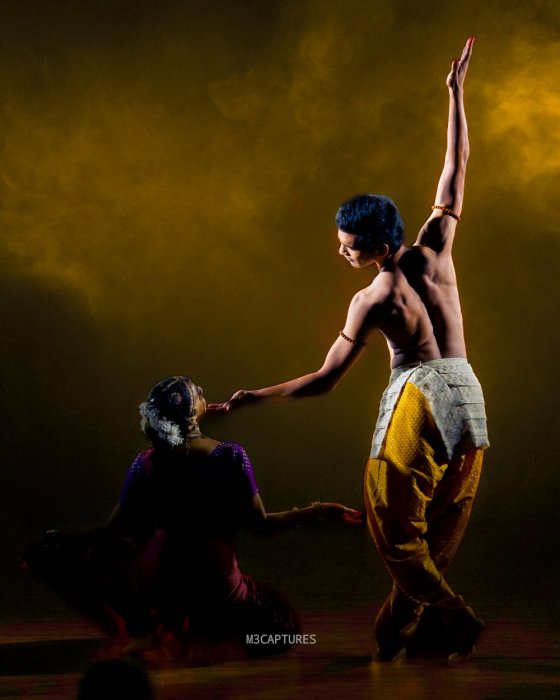 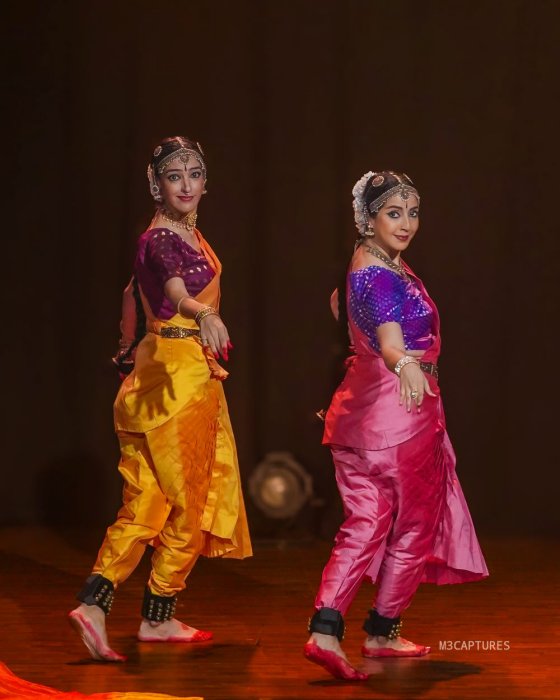 Keelaka Dance Company in Sakhi I watched choreographer Jyotsna Shourie's new dance idea SAKHI in Chennai recently. An imaginary meeting and conversation between SITA and DRAUPADI across "Yugas" and centuries was charming in many parts. One tried by fire, another born from fire. Both "won" by their respective husband princes through the skill of the bow and arrow (Rama and Arjuna). The harsh judgements they both faced through their stories. The production was told through 2 Bharatanatyam female dancers and 3 contemporary male dancers. The duets were a good blend of both styles and the training undergone by the Bharatanatyam artistes in floor work, shifting of weight was apparent. OS Arun's soaring voice created the mood shifts and English dialogue was delivered convincingly by the dance-actors. ADISHAKTI'S LATEST 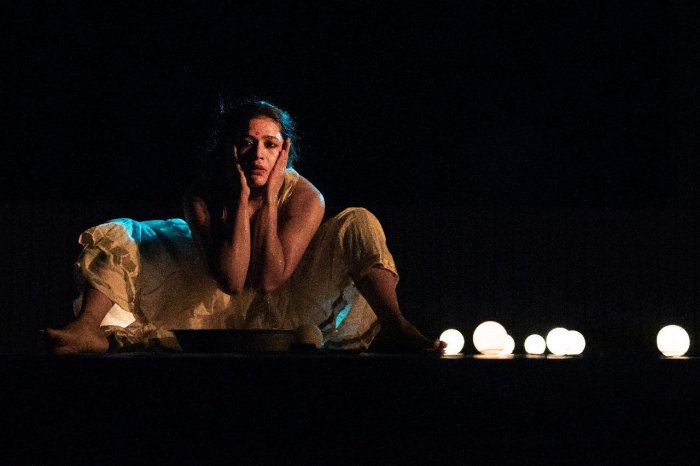 Nimmy Raphel The luminous Nimmy Raphel of Adishakti Theatre brought her newest play URMILA to Chennai. The newly renovated Alliance Francaise auditorium was filled to capacity and I was pleased to see several dancers. URMILA, the play, is about Prince Lakshmana's wife in the Ramayana who is ordered to accept 14 years of sleep to aid her husband's constant vigilance of Prince Rama in exile. Nimmy turns the situation into a woman's protest against patriarchy by refusing to sleep. Two sleep warriors of the Sleep Goddess try to lure her to close her eyes. Nimmy/Urmila, in a stunning display of physical prowess, balancing on stretched bowstrings, reflected water, an exercise ball, mirrors and rolling lights reclaims her right to resist. Savage, enraged and teetering on the verge of sleep, the performance shone with all the hallmarks of founder Veenapani Chawla. Great sound design, superb lighting, demanding physicality and mythology tweaked with humour to make a statement for modern times. So many of you must be planning and rehearsing for your season performances. Several dancers are in the USA and are returning to India later and later - like Sreelakshmy Govardhanan - making connections and furthering their international base. New ideas, twists on familiar mythological stories (Mythili Prakash has a new work ARDHA based on Kali and Siva's dance competition), cross cultural collaborations - there are so many ideas at work. As you all prepare to share your latest venture to the world, here's wishing you the very best in the journey. A HALF CENTURY LATER 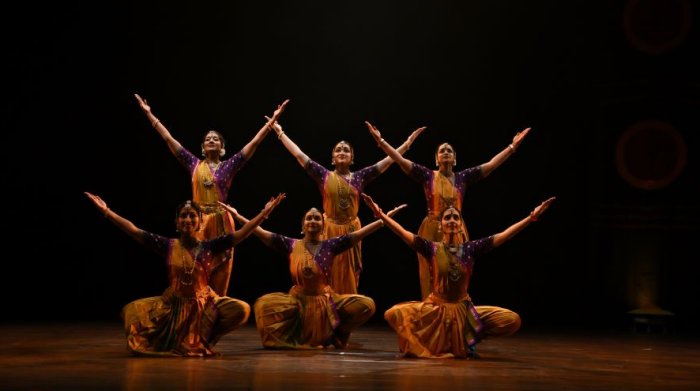 Natya Vriksha Dance Collective (Photo: Sarabjeet Singh Dhillon) I ended the month of October in New Delhi with the 2 day grand celebration of Bharatanatyam dancer and guru Geeta Chandran's 50 years in dance. Ideated with her faithful "dwarapala" husband Rajiv, the event was an elegant celebration of her journey in dance. Geeta recalled her Arangetram debut in New Delhi at age 12 on October 25, 1974 with a poignant short film showcasing comments from her important collaborators in music, design and teaching. All her dance colleagues who were present were honoured. The first day saw the Natya Vriksha Dance Collective delivering ensemble dancing at its synchronised best. The Jatiswaram and Tillana were best examples of how many visual and choreographic design possibilities lay within the Bharatanatyam rubric. Sharanya Chandran's return to the stage with her own choreography for ARDHANAREESWARA, by poet Vidyapati reflected her personal growth as a performer and budding choreographer. Madhura Brushundi delivered a crisp interpretation of the beloved NATANAM ADINAR song on Nataraja. (Photos: Sarabjeet Singh Dhillon) Geeta performed 2 of her favourite solos on the first day but it was her solo performance on Day 2 that was the highlight for me. With powerful vocalist Sudha Raghuraman as a collaborator, Geeta chose 4 pieces to illuminate her journey in music and dance over 50 years. On more than one occasion she turned to smile and acknowledge the orchestral team, reminding us of how important that music connection was for a dancer. Amba Nilambari on Devi was replete with sensuous poses soaked in reposeful adoration of the Goddess. The Tamil varnam - Mogham Aaginen Inda Velayil - by Guru KN Dandayudapani Pillai, shone as an intelligent display of how the demanding "jathi" sections can be reimagined on a maturing body. That footwork alone is sometimes enough when an artiste is in total command of the stage and herself. My favourite Surdas bhajan of Mother Yashoda singing the Ramayana as a lullaby to baby Krishna saw Geeta seated on a dais throughout. In homage to her spiritual guru Shri Goswami of Brindavan, Geeta concluded with the soulful Radha Ramana bhajan where she bathed blossoms on stage and towards her excellent musicians. Geeta, in turn, was bathed in the petals of our praise and admiration. As performer, teacher, collaborator, speaker and writer across languages and geographies, Geeta Chandran's life and art are like a beautiful set of Russian nesting dolls. Layers are uncovered, each with their own patina of discipline and excellence. Geeta Chandran receives the prestigious Nritya Choodamani this December from the Krishna Gana Sabha in Chennai and concludes her successful 3 year turn as Classical dance curator for Goa's Serendipity Festival. I am delighted that my friend and colleague of 30 years looks ahead to new vistas to explore and excel. 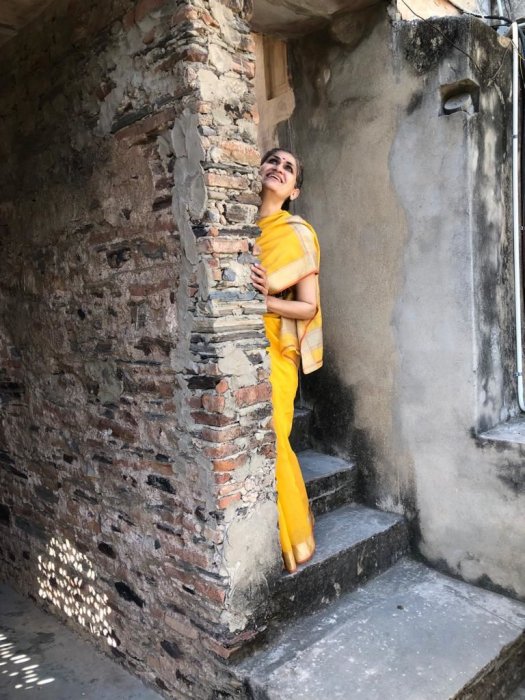 Chitra Dasarathy Another intelligent Bharatanatyam dancer, Chitra Dasarathy, daughter of the late guru C V Chandrasekhar, is also celebrating 50 years of her dance journey in Bangalore. Best wishes from TEAM NARTHAKI for her continuing journey! FAREWELL TO TITANS - VERY DIFFERENTLY Before closing, I would like to leave you with this thought and image. Business mogul Ratan Tata, head of the iconic TATA group of companies passed away in October. There was national and international outpouring of condolences and he was accorded a state funeral with full honours. When the great Yamini Krishnamurthy breathed her last, there were no honours from the government, no wreath, no public condolence. Only a handful of politicians and bureaucrats wrote on their X handles and the dance community of a certain generation recollected her brilliance and mourned her passing. Yamini Akka, who moved lakhs of people, inspired a generation (me included), showcased India to world leaders, received numerous honours, danced almost nonstop for all of her active life, who gave her life for dance - breathed her last in a quiet ceremony ignored by the powerful elite. Let that sink in about how Dance and Dancers are truly regarded in today's hyper blurred world. When we meet again, it will be the last month of the year. There will be a new US President in the Oval office and it will be that time of year when we will recall, recollect, remember and relive the memorable moments of 2024. But that is still a month away. 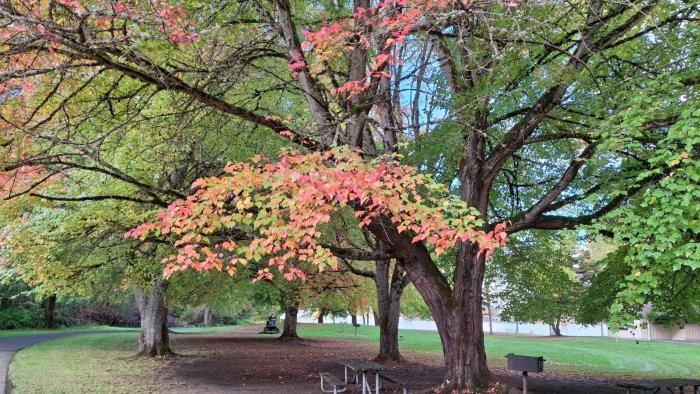 (Photo: Lalitha Venkat) The weather is changing. Somewhere the leaves have turned into gorgeous colours. Sweaters and shawls are coming out or swimsuits and cool cottons are on display - depending on which hemisphere you live in. Let us expand the spirit of the American festival of Thanksgiving to feel and share the gratitude for the life we have at this very moment. It is such a delight and a privilege to spend this time sharing my monthly thoughts with you. Do listen, share and subscribe to our podcast ANITA SAYS on Spotify. Until next time, - Anita R Ratnam anitaratnam.com Connect with us on Instagram and Facebook Post your comments |